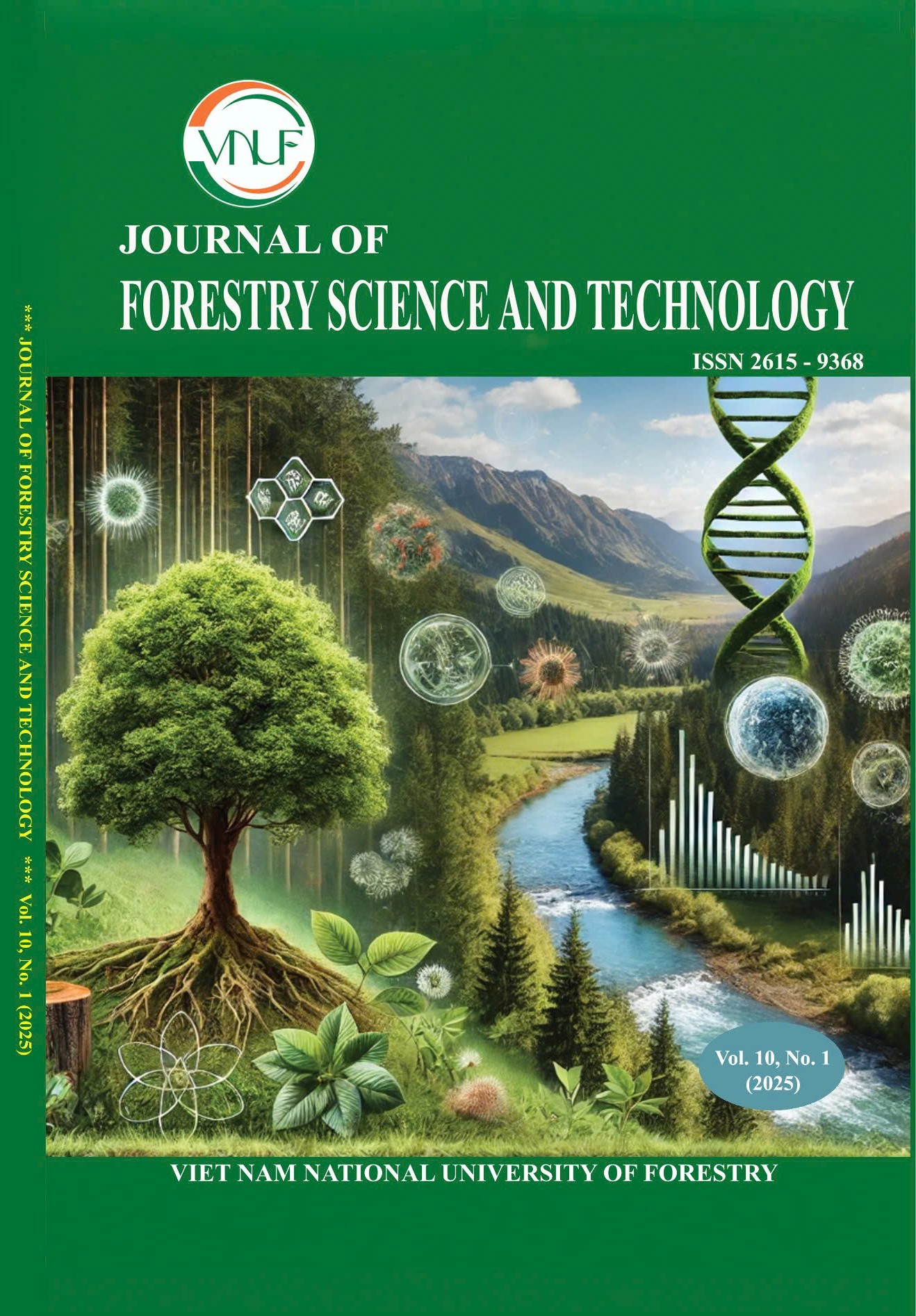Nitrogen stable isotopes composition in soil, plant leaves and response to seasonal changes along an urban-rural environmental gradient
DOI:
https://doi.org/10.55250/Jo.vnuf.10.1.2025.033-041Keywords:
δ15N, site variation, seasonal variation, urban to rural gradientsAbstract
Nitrogen stable isotopes (δ15N) abundance provides useful information on nitrogen input, transformation, and output, which indirectly reflect the characteristics of nitrogen cycling in terrestrial ecosystems. Here, our primary objectives were to: (i) examine how seasonal changes affect the δ15N values in various soil depths, as well as in tree leaves and (ii) compare differences among three forest sites (Shushan National Forest Park_DSS), Zipengshan National Forest Park_ZPS, and Wanfoshan National Forest Park_WFS) representing urban, suburban, and rural environmental conditions in Anhui Province, China. Soil and plant foliar samples were collected seasonally from Quercus acutissima Carruth. forests among the three sites from July 2017 to June 2018. The study results revealed that: (1) There was a significant difference in the δ15N values between the 0-10 cm and 10-20 cm soil depths in all three experimental sites. (2) The seasonal change trends of δ15N in DSS at 0–10 cm soil depth demonstrated that values were highest in fall 2017 and lowest in summer 2017, whereas values at ZPS and WFS sites were highest in summer 2017 and lowest in spring 2018. At 10-20 cm soil depth, DSS and ZPS had maximum δ15N values in Fall 2017 and lowest in summer 2018. (3) The δ15N values in both young and mature leaves were notably greater at the urban sites than those at the suburban and rural sites. The findings from this study revealed that seasonal and site variation significantly increased the Nitrogen stable isotope composition.
References
. Kirsten M Parris (2016). Ecology of urban environments. John Wiley & Sons.
. Yasuaki Tanaka, Elizerberth Minggat & Wardina Roseli (2021). The impact of tropical land-use change on downstream riverine and estuarine water properties and biogeochemical cycles: a review. Ecological processes. 10(1): 1-21.
. Nancy B Grimm, David Foster, Peter Groffman, J Morgan Grove, Charles S Hopkinson, Knute J Nadelhoffer, Diane E Pataki & Debra PC Peters (2008). The changing landscape: ecosystem responses to urbanization and pollution across climatic and societal gradients. Frontiers in Ecology and the Environment. 6(5): 264-272.
. D Johan Kotze, Subhadip Ghosh, Nan Hui, Ari Jumpponen, Benjamin PY‐H Lee, Changyi Lu, Shawn Lum, Richard Pouyat, Katalin Szlavecz & David A Wardle (2021). Urbanization minimizes the effects of plant traits on soil provisioned ecosystem services across climatic regions. Global Change Biology. 27(17): 4139-4153.
. Steward TA Pickett, Mary L Cadenasso, J Morgan Grove, Charles H Nilon, Richard V Pouyat, Wayne C Zipperer & Robert Costanza (2001). Urban ecological systems: linking terrestrial ecological, physical, and socioeconomic components of metropolitan areas. Annual review of ecology and systematics. 32(1): 127-157.
. Nidhi Singh, Saumya Singh & RK Mall (2020). Urban ecology and human health: implications of urban heat island, air pollution and climate change nexus. In: Urban Ecology. Elsevier: 317-334.
. Kate George, Lewis H Ziska, James A Bunce & Bruno Quebedeaux (2007). Elevated atmospheric CO2 concentration and temperature across an urban–rural transect. Atmospheric Environment. 41(35): 7654-7665.
. Cristina E Ramalho & Richard J Hobbs (2012). Time for a change: dynamic urban ecology. Trends in ecology & evolution. 27(3): 179-188.
. Sarah E Kolbe, Arnold I Miller, Guy N Cameron & Theresa M Culley (2016). Effects of natural and anthropogenic environmental influences on tree community composition and structure in forests along an urban-wildland gradient in southwestern Ohio. Urban ecosystems. 19(2): 915-938.
. Jingyuan Li & Tongjin Yang (2015). China's eco-city construction. Springer.
. Xueliang Zhang, Yichun Xie & Lixia Li (2020). Four Decades of Urban and Regional Development and Planning in China. In: Urban and Regional Planning and Development. Springer: 61-81.
. Xing Quan Zhang (2016). The trends, promises and challenges of urbanisation in the world. Habitat international. 54: 241-252.
. Steven M Crum, Sheri A Shiflett & G Darrel Jenerette (2017). The influence of vegetation, mesoclimate and meteorology on urban atmospheric microclimates across a coastal to desert climate gradient. Journal of environmental management. 200: 295-303.
. Zhang Wen, Wen Xu, Qi Li, Mengjuan Han, Aohan Tang, Ying Zhang, Xiaosheng Luo, Jianlin Shen, Wei Wang & Kaihui Li (2020). Changes of nitrogen deposition in China from 1980 to 2018. Environment International. 144: 106022.
. Rieko Urakawa, Nobuhito Ohte, Hideaki Shibata, Kazuo Isobe, Ryunosuke Tateno, Tomoki Oda, Takuo Hishi, Keitaro Fukushima, Yoshiyuki Inagaki & Keizo Hirai (2016). Factors contributing to soil nitrogen mineralization and nitrification rates of forest soils in the Japanese archipelago. Forest Ecology and Management. 361: 382-396.
. Xuejun Liu, Xiaotang Ju, Ying Zhang, Chune He, Jenny Kopsch & Zhang Fusuo (2006). Nitrogen deposition in agroecosystems in the Beijing area. Agriculture, ecosystems & environment. 113(1-4): 370-377.
. Guirui Yu, Yanlong Jia, Nianpeng He, Jianxing Zhu, Zhi Chen, Qiufeng Wang, Shilong Piao, Xuejun Liu, Honglin He & Xuebing Guo (2019). Stabilization of atmospheric nitrogen deposition in China over the past decade. Nature Geoscience. 12(6): 424-429.
. Randeep Kumar, Ravendra Kumar & Om Prakash (2019). Chapter-5 the Impact of Chemical Fertilizers on Our Environment and Ecosystem. Chief Ed. 35: 69.
. Martin Pechout, Petr Jindra, Jan Hart & Michal Vojtisek-Lom (2022). Regulated and unregulated emissions and exhaust flow measurement of four in-use high performance motorcycles. Atmospheric Environment: X. 14: 100170.
. Xulun Zhou, Ang Wang, Erik A Hobbie, Feifei Zhu, Yuying Qu, Luming Dai, Dejun Li, Xueyan Liu, Weixing Zhu & Keisuke Koba (2021). Mature conifers assimilate nitrate as efficiently as ammonium from soils in four forest plantations. New Phytologist. 229(6): 3184-3194.
. Shaonan Huang, Emily M Elliott, J David Felix, Yuepeng Pan, Dongwei Liu, Shanlong Li, Zhengjie Li, Feifei Zhu, Na Zhang & Pingqing Fu (2019). Seasonal pattern of ammonium 15N natural abundance in precipitation at a rural forested site and implications for NH3 source partitioning. Environmental Pollution. 247: 541-549.
. Arshad Arjunan Nair & Fangqun Yu (2020). Quantification of atmospheric ammonia concentrations: A review of its measurement and modeling. Atmosphere. 11(10): 1092.
. Dong-Gill Kim & Marney E Isaac (2022). Nitrogen dynamics in agroforestry systems. A review. Agronomy for Sustainable Development. 42(4): 1-18.
. GS Ortiz-Barbosa, L Torres-Martínez, J Rothschild & JL Sachs (2022). Lotus japonicus regulates root nodulation and nitrogen fixation dependent on the molecular form of nitrogen fertilizer. Plant and Soil. 1-13.
. Dana L. Brenner, Ronald Amundson, W. Troy Baisden, Carol Kendall & Jennifer Harden (2001). Soil N and 15N variation with time in a California annual grassland ecosystem. Geochimica et Cosmochimica Acta. 65(22): 4171-4186.
. Haitao Wang, Christopher W Marshall, Minying Cheng, Huijuan Xu, Hu Li, Xiaoru Yang & Tianling Zheng (2017). Changes in land use driven by urbanization impact nitrogen cycling and the microbial community composition in soils. Scientific reports. 7(1): 1-12.
. Guoyong Yan, Shijie Han, Mingxin Zhou, Wenjing Sun, Binbin Huang, Honglin Wang, Yajuan Xing & Qinggui Wang (2020). Variations in the natural 13C and 15N abundance of plants and soils under long-term N addition and precipitation reduction: interpretation of C and N dynamics. Forest Ecosystems. 7(1): 49.
. Yuqing Xu, Jicheng He, Weixin Cheng, Xuerong Xing & Linghao Li (2010). Natural 15N abundance in soils and plants in relation to N cycling in a rangeland in Inner Mongolia. Journal of Plant Ecology. 3(3): 201-207.
. Claire Billy, Gilles Billen, Mathieu Sebilo, François Birgand & Julien Tournebize (2010). Nitrogen isotopic composition of leached nitrate and soil organic matter as an indicator of denitrification in a sloping drained agricultural plot and adjacent uncultivated riparian buffer strips. Soil Biology and Biochemistry. 42(1): 108-117.
. Naomi S Wells, W Troy Baisden & Tim J Clough (2015). Ammonia volatilisation is not the dominant factor in determining the soil nitrate isotopic composition of pasture systems. Agriculture, Ecosystems & Environment. 199: 290-300.
. M Ciezka, M Modelska, M Gorka, A Trojanowska-Olichwer & D Widory (2016). Chemical and isotopic interpretation of major ion compositions from precipitation: a one-year temporal monitoring study in Wroclaw, SW Poland. Journal of Atmospheric Chemistry. 73(1): 61-81.
. Hong-Wei Xiao, Hua-Yun Xiao, Ai-min Long & Yan-Li Wang (2012). Who controls the monthly variations of NH4+ nitrogen isotope composition in precipitation? Atmospheric Environment. 54: 201-206.
. Yuanwen Kuang, Fangfang Sun, Dazhi Wen, Zhihong Xu, Longbin Huang & Jiong Li (2011). Nitrogen deposition influences nitrogen isotope composition in soil and needles of Pinus massoniana forests along an urban-rural gradient in the Pearl River Delta of south China. Journal of Soils and Sediments. 11(4): 589-595.
. Cremildo António Luís Francisco, Arcângelo Loss, Gustavo Brunetto, Rogério Gonzatto, Sandro José Giacomini, Celso Aita, Marisa de Cassia Piccolo, Carina Marchezan, Gustavo Scopel & Ricardo Fagan Vidal (2021). Aggregation, carbon, nitrogen, and natural abundance of 13C and 15N in soils under no-tillage system fertilized with injection and surface application of pig slurry for five years. Carbon Management. 12(3): 275-287.
. Miao Zhang, Renjie Hou, Tianxiao Li, Qiang Fu, Shoujie Zhang, Anshuang Su, Ping Xue & Xuechen Yang (2022). Study of soil nitrogen cycling processes based on the 15N isotope tracking technique in the black soil areas. Journal of Cleaner Production. 375: 134173.
. Klaus Kaiser & Karsten Kalbitz (2012). Cycling downwards–dissolved organic matter in soils. Soil Biology and Biochemistry. 52: 29-32.
. Phillip M Chalk, Caio T Inácio & Deli Chen (2019). An overview of contemporary advances in the usage of 15N natural abundance (δ15N) as a tracer of agro-ecosystem N cycle processes that impact the environment. Agriculture, Ecosystems & Environment. 283: 106570.
. Caijuan Li, Bo Wang, Tuo Chen, Guobao Xu, Minghui Wu, Guoju Wu & Jinxiu Wang (2019). Leaf Age Compared to Tree Age Plays a Dominant Role in Leaf δ13C and δ15N of Qinghai Spruce (Picea crassifolia Kom.). Forests. 10(4): 310.
. Arvin R Mosier (2001). Exchange of gaseous nitrogen compounds between agricultural systems and the atmosphere. Plant and Soil. 228(1): 17-27.









